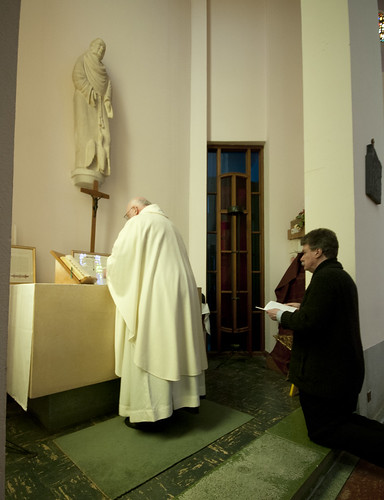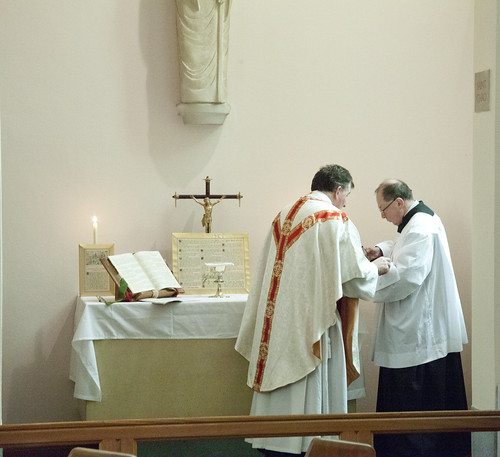 |
| Silent prayer by the priest: a private Mass at the LMS Priest Training Conference |
In his great book The Spirit of the Liturgy Cardinal Ratzinger, as was, now Pontiff Emeritus Benedict XVI, had a lot to say about silence in the liturgy, and the problem represented by its almost complete exclusion from the Ordinary Form. We must remember, first, that silence takes various forms; he is concerned with two: the 'priestly prayers', personal prayers for worthiness said silently by the priest before reading the Gospel, receiving Communion and so on, and the Canon, said silently in the EF but not in the OF. He rejects as an artificial holding-up of the liturgy the 'pauses' inserted into the Ordinary Form by many celebrants (and sometimes called for by the rubrics).
No apologies for an extended quotation.
Spirit of the Liturgy pp212-3
There is a silence which is part of the liturgical action, not an interruption. I am thinking of the silent prayers of the priest. Those who hold a sociological or activistic view of the priest's duties in the Mass frown upon these prayers, and, whenever possible, they leave them out. The priest is defined in a narrowly sociological and functionalistic way as the "presider" at the liturgical celebration, which is thought of as a kind of meeting. If that is what he is, then, of course, for the sake of the meeting, he has to be in action all the time. But the priest's duties in the Mass are much more than a matter of chairing a meeting. The priest presides over an encounter with the living God and as a person who is on his way to God. The silent prayers of the priest invite him to make his task truly personal, so that he may give his whole self to the Lord. They highlight the way in which all of us, each one personally yet together with everyone else, have to approach the Lord. The number of these priestly prayers has been greatly reduced in the liturgical reform, but, thank God, they do exist…
Meanwhile, in their efforts to reform the Missal, the German liturgists have explicitly stated that, of all things, the Eucharistic Prayer, the high point of the Mass, is in crisis. Since the reform of the liturgy an attempt has been made to meet the crisis by incessantly inventing new Eucharistic Prayers, and in the process we have sunk more and more into banality. Multiplying words is no help -- that is all too evident. ...they balk, now as in the past, at the possibility that silence too, silence especially, might constitute communion before God.
Anyone who has experienced a church united in the silent praying of the Canon will know what a really filled silence is. It is at once a loud and penetrating cry to God and a Spirit-filled act of prayer. Here everyone does pray the Canon together, albeit in a bond with the special task of the priestly ministry. Here everyone is united, laid hold of by Christ, and led by the Holy Spirit into that common prayer to the Father which is the true sacrifice—the love that reconciles and unites God and the world.
So we see the familiar shape of the debate.
1. The implications of the traditional liturgy: it points towards both the priest's personal need for holiness, and the importance of silent communion with God.
2. The official motivation of the reform: again, participation, which seems obviously enhanced by 'being able to hear what is going on'
3. The alleged implications of the reformed liturgy: that Mass is a meeting, that it is about communication not with God but between the priest and the Faithful, or even among the latter.
(3) is at right angles to (1) and (3) is wrong. Seen in the light of the whole liturgical tradition (3) is actually crazy, and deeply damaging. But it is insidiously inflential. Another implication, of course, is that since the point of silence in the Vetus Ordo is not understood, it is condemned as obscurantist, clericalist, and so on.
On this point we actually have some explicit teaching from the Papal magisterium. Silence was condemned by the Jansenist 'Synod of Pistoia', which was itself condemned by Pope Pius VI.
Bull Auctorem Fidei (1794) 33: ‘The proposition of the synod by which it shows itself eager to remove the cause through which, in part, there has been induced a forgetfulness of the principles relating to the order of the liturgy, “by recalling it (the liturgy) to a greater simplicity of rites, by expressing it in the vernacular language, by uttering it in a loud voice”; as if the present order of the liturgy, received and approved by the Church, had emanated in some part from the forgetfulness of the principles by which it should be regulated,— rash, offensive to pious ears, insulting to the Church, favourable to the charges of heretics against it.’
So there you have it. The hermeneutic of continuity is not incompatible with a critique of the New Mass, and it certainly isn't about blinding oneself to the differences between the Old and the New. It is about seeing every authorised rite and magisterial document in the light of the whole body of tradition. This will sharpen our understanding of the radical nature of the reform, which (as Vatican II indicated) is in itself problematic: liturgical reform, the Council said, should not be radical (Sacrosanctum Concilium 23). But at the same time it allows us to dismiss those implications of the new rites which appear to establish a new theology at odds with the theology endorsed by the Church over many centuries.
Different rites have different but complimentary theological emphases: the Council makes this point about the Eastern Rites (see Unitatis Redintegratio 17). What is impossible is that having promulgated the new, the Church should condemn the old. Pope Benedict condemned this is in the most forceful terms. He had to, because this is how it is often presented: by seminary liturgy lecturers, by writers like Basil Loftus, and by many others. These people like to point out that they are following the lead of theologians who were involved in the Reform itself, but this has no importance. Those theologians have no magisterial authority. What is promulgated by the Church must be interpreted by the norms proper to the Church: the Tradition.
I had intended to write also about Cardinal Ratzinger on kneeling, but with Christmas approaching I think I have said enough on this issue. The general point is applicable to a whole host of other issues. The Vetus Ordo has always been, and remains, a massive element of the Church's liturgical tradition, whose theological exactitude cannot seriously be called into question. What can, and must, be questioned are the alleged implications of the Novus Ordo which are held to sweep away the Church's established teaching. To repeat, it is vital for orthodoxy that the Old Rite becomes once more a serious part of the Church's liturgical life all over the world.
 |
| 'Lavabo inter innocentes': said inaudibly by the priest. |
Thank you for this post. I have a sneaky suspicion that only those in the EF will be able to face the political and cultural storms to come for many reasons, especially in Britain.
ReplyDeleteAs to the Pope Emeritus on the EF, we owe him a huge debt of gratitude for the SP. May we never forget to pray for him.
from kwtraditionalcatholic site:
ReplyDelete'the following apology by Pope John Paul II (addressing bishops in 1980), quoted in a beautiful letter (1988) by Most Rev. John R. Keating: I WOULD LIKE TO ASK FORGIVENESS — in my own name and in the name of all of you, venerable and dear brothers in the episcopate — for everything which, for whatever reason, through whatever human weakness, impatience or negligence, and also through the (at times) partial, one-sided, and erroneous application of the directives of the Second Vatican Council, may have caused scandal and disturbance concerning the interpretation of the doctrine and the veneration due to this great sacrament.'